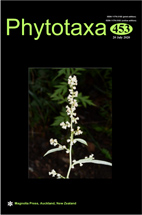Abstract
Tursiocola, a presumably exclusively epizoic diatom genus, comprises species found on various aquatic animals such as cetaceans, manatees, and marine and freshwater turtles. The genus is characterised by linear or lanceolate valves with well-developed pseudosepta at both poles, a valvocopula with three pairs of siliceous tabs, and a butterfly-like structure extending from the central nodule on the internal side of the valve. The current study describes a novel species of Tursiocola, T. neliana Majewska sp. nov. that grows epizoically on leatherback sea turtles from the Eastern Coast of South Africa based on detailed observations using light and scanning electron microscopy. The new taxon resembles the other currently known sea turtle-associated Tursiocola species in possessing relatively small, slightly heteropolar valves with acute apices and a strongly reduced butterfly structure on the internal side. However, T. neliana differs from all other members of the genus in being distinctly dorsiventral, with a clearly bowtie-shaped central area, unequal stria density on two sides of the raphe-sternum, and up to 8 areolae per stria. The description of the new taxon brings the total number of the sea turtle-associated Tursiocola species known so far up to four. An emended description of Tursiocola is proposed based on the new observations presented in this and other recent reports. Furthermore, the current understanding of the genus ecology is summarised.

